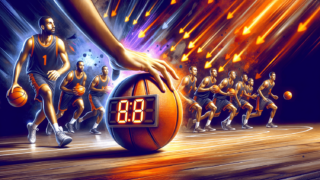
If you’re looking to elevate your basketball knowledge or enhance your understanding of advanced tactics, you’ve come to the right place! In this insightful blog post, we will delve into the world of basketball strategy, with a specific focus on the intriguing concept of the double team. Whether you’re an aspiring player, an enthusiast, or simply curious about this popular game strategy, by the end of this post, you’ll definitely develop a strong understanding of what it means to double team in basketball and how it can transform gameplay in the blink of an eye. So, let’s lace up our sneakers, grab a water bottle, and get ready to learn!
What Is a Double Team in Basketball?
A double team in basketball is a defensive strategy where two defenders actively guard a single offensive player, significantly reducing their opportunities to score or make productive plays. By applying pressure and limiting the space of the offensive player, the defense aims to force them to pass the ball, commit a turnover or a bad shot, and ultimately disrupt the opposing team’s offensive flow.
Unlocking the Art of the Double Team
Combining both individual skill and a tactical mindset, the double team can be an essential part of any basketball team’s defensive arsenal. But how can you use this strategy effectively, and what are the key principles you need to know? Read on as we explore the nuances of the double team and break down the different scenarios where this tactic can be effectively deployed on the court.
The Mechanics Behind the Double Team
In order to fully comprehend the double team in basketball, we need to understand the basic mechanics behind it. Here, we’ll break down the fundamentals, different types, and mechanisms of double-teaming in basketball.
1. Strong Side Double Team
This type of double team focuses on the ball handler who is currently in possession of the ball. The two defenders primarily target the player when they have the best chance of creating a turnover or forcing a bad pass, for example when the offensive player is pinned down close to the sideline or the baseline. The idea is to prevent their escape, limit their visibility in passing, and pressure them into making a mistake.
2. Weak Side Double Team
A weak side double team occurs when the defenders target an offensive player without the ball. This typically happens when that player is a dominant scorer or playmaker, and the defense wishes to deny them the ball. Many times, this will involve a defender leaving their assigned player to help a teammate neutralize the targeted player, forcing the offense to change their strategy.
Timing and Spatial Awareness
Double-teaming may sound simple enough in theory, but in practice, timing and spatial awareness are essential for its successful execution. Players must be able to read the game effectively and recognize the right moments to initiate a double team. The ideal time to strike is when the targeted offensive player is vulnerable and has limited options, such as when they’re trapped in a corner or have poor court vision.
Effective Communication and Trust
Without proper communication and trust between teammates, a double team can quickly backfire. Players must always be aware of their positioning and the responsibilities of their teammates, as well as be willing to quickly rotate and cover for each other’s movements. Regular practice can help develop a strong chemistry between players, while also minimizing the risk of leaving an opponent open for an easy score.
Factors to Consider Before Double Teaming
Before committing to a double team, several factors need to be taken into account, such as:
1. The Skill Level of the Offensive Player
Think about whether the player you’re looking to double team is a significant threat to the offense. Is the player a top scorer, a skilled passer, or a great ball handler? If they pose a major risk to your team’s defense, a double team may be a valuable option to consider.
2. The Alignment of Your Defense
How are you currently aligned defensively? Does your team play man-to-man or zone defense most of the time? The answer may affect the feasibility of a successful double team. In some cases, it may require leaving another offensive player temporarily open, which could potentially result in a disadvantage for your defense.
3. The Abilities of Your Defenders
Can your defenders handle the responsibilities associated with double-teaming? Is the additional player who is leaving their assignment quick and agile enough to recover and contest a shot or pass after providing double-team help? Assessing the abilities of your defenders is key to a successful double team.
Advantages and Disadvantages of Double Teaming
Implementing a double team in basketball can come with a set of advantages and disadvantages. Let’s take a look at both sides of the coin:
Advantages:
- Forcing turnovers – Double-teaming can increase the possibility of forcing the offensive player into a turnover through bad passes, steals, or traveling violations.
- Pressuring dominant players – By focusing two defenders on a key player, you can lessen their impact on the game and prevent them from getting into a scoring rhythm.
- Breaking offensive flow – The double team can disrupt the opposing team’s offensive flow, making it difficult for them to execute their game plan.
Disadvantages:
- Leaving an opponent open – Committing two players to a single opponent might leave another player open on the floor, resulting in easy scoring chances if the double team is not executed quickly and efficiently.
- Rotation risks – Players must be able to rotate and cover for each other effectively in a double team situation, or else the defense may be caught off-balance, allowing easy penetration and scoring opportunities.
- Increased fatigue – Frequent double-teaming can increase the physical demands on players, as they are required to constantly react and adjust their positioning on the court.
Double Teaming in Professional Basketball
While the double team strategy is frequently used in amateur and college basketball, you can also witness this tactic in action at the professional level. NBA coaches and players have employed double teams as a means of neutralizing the scoring threats of some of the game’s most dominant players. From the famed “Jordan Rules” implemented by the Detroit Pistons in the late 1980s and early 1990s to combat Michael Jordan’s scoring prowess, to contemporary examples involving players like LeBron James and Stephen Curry, the double team has become a tried-and-true method within the world of professional basketball.
Tips for Successfully Executing Double Teams
To wrap things up, here are some essential tips to keep in mind when looking to incorporate the double team into your team’s defensive strategy:
- Continuously work on improving your team’s communication, defensive awareness, and trust through practices and drills.
- Analyze your opponent’s offense and identify specific threats that may warrant double-teaming efforts during games.
- Monitor your defenders’ energy levels to ensure they can maintain their defensive intensity and commitment to executing the double team throughout the game.
- Practice situational double teams and player rotations, giving your team members the opportunity to develop familiarity and confidence in their roles.
By keeping these tips in mind, you can elevate your team’s defensive prowess and become a force to be reckoned with on the basketball court. Now get out there and give it your best shot!
Utilizing Misdirection to Counter Double Teams
To round out our comprehensive look at double teams in basketball, it’s important to touch on the flip side of the coin – how offenses can effectively counter these pressure-packed defensive tactics. After all, the best defense is a good offense, right? So let’s dive into how you can outsmart double teams and regain the upper hand on the court.
Offensive Strategies to Beat the Double Team
When faced with a double team, having a variety of offensive strategies up your sleeve can help alleviate the pressure and create scoring opportunities. The following tactics can be particularly effective in neutralizing a suffocating double team:
1. Quick Ball Movement
Speed is your friend when trying to beat a double team. Swing the ball quickly around the perimeter and look for the open teammate who’s been left unguarded due to the double team. Quick, crisp passes can leave the defense scrambling and create wide-open shooting opportunities.
2. Set Screens
Setting screens for the player being double-teamed can help create space and disrupt the double team’s effectiveness. By forcing the defenders to navigate around the screen, you can give your teammate enough room to operate and make a play.
3. Use Spacing and Proper Court Alignment
One of the best ways to counter a double team is to position your teammates strategically across the court. Excellent spacing forces the defense to cover more ground and increases the likelihood that a defender will be late in rotating to cover an open player.
4. Exploit Gaps and Attack the Basket
If a player successfully splits the double team, they can drive to the basket for an easy score or pass to an open teammate for a high-percentage shot. Particularly crafty ball handlers may be able to dribble through the double team, forcing the defense to collapse and opening up opportunities for teammates.
5. Develop the Skills of Your Supportive Cast
Having a balanced scoring attack and multiple playmakers makes it difficult for an opposing team to feel confident in their decision to double team. By developing the skills and confidence of all players within your team, you reduce their reliance on one or two star players and make your offense less predictable.
Key Takeaways for Offensive Players
Now that we’ve explored the strategies to counter double teams, let’s put it all together. Here are some key takeaways for offensive players facing double teams:
- Keep your head up, maintain court vision, and be aware of open teammates and passing lanes.
- Develop strong ball-handling skills to maximize your ability to escape or split the double team.
- Remain composed under pressure and don’t force bad passes or shots when faced with a double team.
- Anticipate the double team and work on honing your decision-making skills to quickly identify the best course of action.
- Continuously work on improving your individual skills and synergy with your teammates to create a more versatile and unpredictable offense.
By mastering these offensive strategies and embracing a team-centric approach, you can overcome even the most ferocious double teams and contribute to your team’s success on the basketball court. With time, practice, and dedication, pulling off a successful counter to double teams becomes as satisfying as sinking a game-winning shot. Keep up the hard work and watch your basketball IQ soar!
Frequently Asked Questions
In this FAQ section, we will address some common questions that readers may have about double teams in basketball. These questions and answers will help deepen your understanding of this strategic concept and empower you to make more informed decisions on the court. Let’s jump into these burning queries!
1. When should a double team be initiated?
A double team should be initiated when the targeted offensive player is vulnerable and has limited options, typically when they are trapped in a corner or have poor court vision. The ideal timing will vary depending on the situation and matchup.
2. How can a coaching staff determine whether to use a double team?
Coaching staff should consider several factors like the skill level of the offensive player they are considering to double team, the alignment of their defense, and the abilities of their defenders. The effectiveness of a double team in disrupting an opponent’s game plan will also be a key determinant.
3. What are some disadvantages of a double team?
The main disadvantages of a double team include leaving an opponent open, rotation risks, and increased fatigue for the players who are providing help defense.
4. How can an offensive player break a double team?
An offensive player can break a double team by staying composed, maintaining court vision, making quick and decisive passes, utilizing screens, and employing effective dribbling techniques.
5. How does a double team affect the defense’s responsibilities?
When executing a double team, the defense’s responsibilities shift as players must rotate and cover their teammates’ movements in order to prevent open shots or easy penetration by opposing players.
6. How can a double team improve overall defensive performance?
A double team can improve overall defensive performance by forcing turnovers, pressuring dominant players, and breaking the offensive flow of the opposing team, making it harder for them to execute their game plan.
7. How does court spacing factor into the effectiveness of a double team?
Court spacing is crucial to the effectiveness of a double team. Proper spacing forces the defense to cover more ground, increases the likelihood of a defender being late in rotating, and can create open opportunities for the offense to exploit.
8. What are some common mistakes when double-teaming?
Some common mistakes include initiating a double team at a poor time or location, poor communication between teammates, and a slow or insufficient player rotation, which can leave an opponent open for an easy score.
9. Can a double team be used in both man-to-man and zone defensive schemes?
Yes, a double team can be employed in both man-to-man and zone defensive schemes. However, the specific execution and player rotations will vary depending on the defensive alignment.
10. How does the type of offensive player being double-teamed impact the strategy?
The type of offensive player being double-teamed will dictate the specific tactics employed, such as whether to pressure them on the catch, deny them the ball entirely, or focus on quick rotations to recover to open players elsewhere on the court.
11. Are there some situations where a double team is not recommended?
There are situations where a double team is not recommended, such as when the targeted player is not a significant threat, the defense is misaligned, or when the defenders are not quick, agile, or experienced enough to recover or contest shots after providing help defense.
12. How can a team practice and sharpen their double-teaming skills?
Teams can practice and sharpen their double-teaming skills through drills designed to develop defensive awareness, communication, trust, and quick decision-making within the team. Repeated practice will help build familiarity with the tactic and the roles of individual players.
13. How do professional basketball teams utilize double teams?
Professional basketball teams use double teams to neutralize scoring threats and disrupt opposing offenses. Famous examples include the “Jordan Rules” for guarding Michael Jordan and various tactics employed against modern-day stars like LeBron James and Stephen Curry.
Featured Posts
- No pillar pages found.





